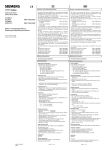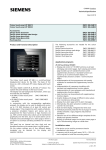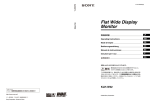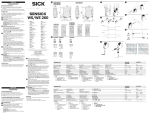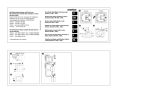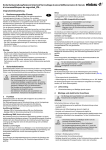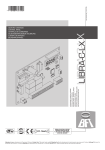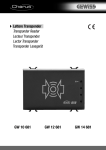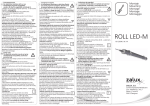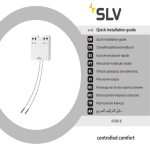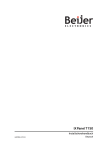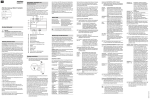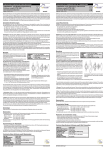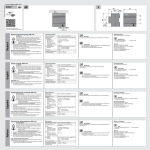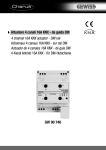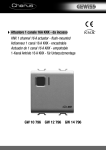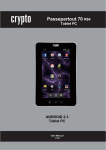Download Anzeige - Futurasmus KNX Group
Transcript
D GAMMA instabus Farb-Touch-Panel Colour touch panel UP 588/13 AC 230 V UP 588/23 AC/DC 24 V 5WG1 588-2AB13 5WG1 588-2AB23 Bedien- und Montageanleitung Operating and Mounting Instructions Stand: März 2010 Issued: March 2010 Product- and Applications Description The Colour touch panel UP 588 is a multi-functional display/control device for the KNX. The basis of the device is a 320 × 240 pixels TFT colour display with touch screen. The colour depth is 263 K (R, G, B 6-bit), 218 colours. You operate the panel directly via the touch screen. The display has LED background illumination, which you dim with the user interface. • UP 588/13 Colour touch panel 5WG1 588-2AB13 230V AC • UP 588/23 Colour touch panel 5WG1 588-2AB23 24V AC/DC In conjunction with the corresponding application program, the display can be used to display and control up to 110 KNX functions of at least 20 control and display pages. Time programmes with weekly schedules, a presence simulation feature and scenes can be programmed for these functions or logic functions set up. With a trend module status values can be display graphically over the time. Up to 16 active alarms can be indicated and acknowledged on a alarm page or there is an option to use these activating conditions for 16 event tasks. The panel has an internal real time clock and can therefore function as the master timer in a KNX system. Via the system settings one of four different design templates can be selected for the display and operator interface. Weitere Informationen Additional Information http://www.siemens.de/gamma http://www.siemens.com/gamma Technische Daten Technical Specifications Spannungsversorgungen • Busspannung: erfolgt über die Buslinie • Externe Spannungsversorgung für: • Touch-Panel UP 588/13 230 V AC ±10%, 50/60 Hz • Touch-Panel UP 588/23 18 - 36V DC, 400 mA, basisisoliert gegenüber 230 V 14 - 28V AC, 50/60 Hz, 400 mA, basisisoliert gegenüber 230 V Power supplies • Bus voltage: via the bus line • External power supply for: • Colour Touch panel UP 588/13 230 V AC ±10%, 50/60 Hz • Colour Touch panel UP 588/23 18 – 36 V DC, 400 mA, base isolated compared with 230 V 14 – 28 V AC, 50/60 Hz, 400 mA, base isolated compared with 230 V Bedienelemente • Lerntaste zum Umschalten Normal- / Adressiermodus • Reset-Taste zum Rücksetzen des Gerätes • Resistiver Analog-Touch mit berührungssensitiver Fläche auf dem Display Operating elements • Programming button to toggle between normal and addressing modes • Reset button to reset the device • Resistive analogue touch with contact-sensitive area on the display • Lebensdauer der Displayhintergrundbeleuchtung: 70000 Std. (Helligkeit > 50 % der Originalhelligkeit) Anzeigeelemente • Programmier - LED rot zur Anzeige Normal/Adressiermodus • Grafikfähiges TFT-Farbdisplay 320 x 240 Pixel (1/4 VGA) mit LED-Hintergrundbeleuchtung Anschlüsse • Buslinie: Busklemme KNX, schraubenlos 0,6 ... 0,8 mm ∅ eindrähtig Abisolierlänge 5 mm • USB-Buchse Mini Typ B (Verwendung nur im Bedarfsfall, zum Laden der Bilder und Symbole) • Spannungsversorgung Abisolierlänge: 6...7 mm Es sind folgende Leiter/Leiterquerschnitte zulässig: - 0,5...2,5 mm2 eindrähtig - 0,5...1,5 mm2 feindrähtig Mechanische Daten • Gehäuse Touch Panel: Kunststoff • Aussenabmessungen Displaymodul (B x H x T): 157 x 131 x 60 mm • Aussenabmessungen der Designrahmen (B x H x T): 194 x 156 x 5 mm • Aussenabmessungen des Passepartoutrahmen (B x H): 152 x 123 mm • Einbautiefe in UP-Dose: 64 mm • Montage: wird in zugehörige UP-Dose eingeschraubt • Abmessungen zugehörige UP-Dose (BxHxT): 161,5 x 135 x 64 mm , nicht im Lieferumfang enthalten • Gewicht: ca. 510 g EMV-Anforderungen Erfüllt EN 50090-2-2 Umweltbedingungen • Klimabeständigkeit: EN 50090-2-2 • Umgebungsbedingungen im Betrieb: 0°C bis +45°C • Lagertemperatur: -25°C bis +70°C • Rel. Feuchte (nicht kondensierend): 5 % bis 93 % Prüfzeichen KNX/EIB CE-Kennzeichnung Gemäss EMV-Richtlinie (Wohn- und Zweckbau), Niederspannungsrichtlinie A5E02834306C DS01 GB Produkt- und Funktionsbeschreibung Das Farb-Touch-Panel UP 588 ist ein multifunktionales Anzeige-/ Bediengerät für den KNX-Bus. Basis des Gerätes ist ein 320 x 240 Pixel TFT-Farbdisplay mit Touchscreen. Die Farbtiefe beträgt 263 K (R,G,B 6Bit), 218 Farben. Bedient wird das Panel direkt über den Touchscreen. Das Display verfügt über eine LED-Hintergrundbeleuchtung, die über die Bedienoberfläche dimmbar ist. • Touch-Panel UP 588/13 5WG1 588-2AB13 AC 230V • Touch-Panel UP 588/23 5WG1 588-2AB23 AC / DC 24V In Verbindung mit dem zugehörigen Applikationsprogramm kann das Display zur Darstellung und Bedienung, von bis zu 110 KNX-Funktionen auf 20 Bedien- und Anzeigeseiten, eingesetzt werden. Für diese Funktionen können Zeitprogramme mit Wochenschaltplänen, eine Anwesenheitssimulation, Szenen programmiert oder Logikfunktionen parametriert werden. Mit einem Trendmodul können Statuswerte über die Zeit grafisch dargestellt werden. Auf einer Alarmseite können bis zu 16 eintreffende Alarme angezeigt und quittiert werden oder es besteht die Möglichkeit diese Auslösebedingungen für 16 Ereignisaufträge zu nutzen. Das Panel besitzt eine interne Echtzeituhr und kann damit als Zeitmaster in einem KNX-System fungieren. Über die Systemeinstellung kann eine von vier unterschiedlichen Designvorlagen zur Bedien- und Anzeigeoberfläche gewählt werden. Für das Touch-Panel ist folgende Auswahl als Zubehör erforderlich: Designrahmen Aluminium 5WG1 588-8AB12 Designrahmen Edelstahl Design 5WG1 588-8AB13 Designrahmen Glas schwarz 5WG1 588-8AB14 Designrahmen Glas weiss 5WG1 588-8AB15 Einbau-/Hohlwanddose 5WG1 588-8EB01 Seite 1 von 4 The following choice as accessories is needed for the colour touch panel: Desig frame aluminium 5WG1 588-8AB12 Design frame stainless steel design 5WG1 588-8AB13 Design frame glass black 5WG1 588-8AB14 Design frame glass white 5WG1 588-8AB15 Relevant flush-type box 5WG1 588-8EB01 • Life time of the display backlight: 70000 h (brightness > 50 % the original brightness) Display elements • Red programming LED for displaying normal/addressing mode • Graphics-capable TFT colour display 320 × 240 pixels (1/4 VGA) with LED background lighting Connections • Bus line: KNX bus terminal, screwless 0.6... 0.8 mm ∅ solid, stripped length 5 mm. • USB socket mini type B (use only if needed for image and symbols load) • Power supply stripped length: 6...7 mm The following conductor/conductor cross-sections are permitted: - 0.5...2.5 mm2 solid - 0.5..0.1.5 mm2 finely-stranded Mechanical data • Housing: Touch panel: plastic • Outer dimensions of the display modul (W x H x D): 157 x 131 x 60 mm • Outer dimensions of the design frame (W × H × D): 194 × 156 × 5 mm • Outer dimensions of the passepartout blind (W × H): 152 × 123 mm • Mounting depth in flash-type box: 64 mm • Installation: is screwed into the corresponding flush-type box • Dimensions of corresponding flush-type box (W × H × D): 161.5 × 135 × 64 mm, not included with supply • Weight: approx. 510 g EMC requirements Complies with EN 50090-2-2 Ambient conditions • Climatic withstand capability: EN 50090-2-2 • Ambient operating conditions: 0°C to +45°C • Storage temperature: -25°C to +70°C • Relative humidity (non-condensing): 5% to 93% Markings KNX/EIB CE-mark In accordance with the EMC guideline (residential and functional buildings) and the low voltage guideline Page 1 of 4 Lage- und Funktion der Anzeige- und Bedienelemente Location and Function of the Display and Operating Elements Die Geräteanschlüsse, sowie die bei der Inbetriebnahme benötigten Elemente Lerntaste und Programmier-LED sind auf der Geräterückseite zugänglich. Bild 1 zeigt die Geräterückseite The device connections as well as the programming button and programming LED which are required for the commissioning stage are accessible at the back of the device. Figure 1 shows the back of the device. A B C D A B C D Bild 1: Lage der Anschluss- und Bedienelemente Figure 1: Location of the connection and operating elements Anschlussklemme 230 V bzw. 24 V AC/DC Programmier - LED Lern - Taste Busklemme Connection terminal 230 V or 24 V DC Programming LED Programming button Bus terminal Der Anschluss der Busleitung erfolgt über eine Standardbusklemme, die in die entsprechende Klemmenaufnahme auf der rechten Gehäuseseite eingesteckt ist D. Links neben dem Steckplatz für die Busklemme befinden sich die Lern-Taste C und die Programmier-LED B. Die Anschlussklemme für die 230 V Netzversorgung oder bei der 24 V Variante für die 24 V AC/DC Versorgung befindet sich auf der linken Geräteseite A. Zum Anschluss der Spannungsversorgungsleitung muss die Klemme abgezogen werden. Die auf dem Gehäuse gekennzeichnete Anschlussfolge ist unbedingt zu beachten! The bus cable is connected via a standard bus terminal D, which is plugged into the corresponding terminal slot on the right side of the housing. On the left, beside the plug-in slot for the bus terminal are the programming button C and the programming LED B. The connection terminal for the 230 V power supply or, in the 24 V version for 24 V AC/DC supply are on the left side A of the device. The terminal must be removed to connect the power supply. It is essential to obey the connection sequence marked on the housing! Montage und Verdrahtung Mounting and Wiring Installationshinweise • Das Gerät ist für feste Installation in Innenräumen, für trockene Räume, vorgesehen • Zum Einbau der Montagedose ist ein Mauer- oder Hohlwandausbruch von 161,5 x 135 x 64 mm erforderlich (siehe Bild 2). • Die Einbautiefe des Ausbruches muss mindestens 64 mm betragen Installation directions • The device is designed for fixed installation in interior rooms, for dry rooms. • To install the assembly socket, a wall or hollow wall outbreak of 161.5 x 135. x 64 mm is required (see figure 2). • The installation depth of the outbreak must be at least 64 mm. V Bild 2: Bohrskizze für Holwanddose Figure 2: Drilling jig for cavity wall box A B C D V GEFAHR • Das Gerät darf nur von einer zugelassenen Elektrofachkraft installiert und in Betrieb genommen werden. • Das Gerät darf nur in Verbindung mit den genannten Zubehörteilen, insbesondere der genannten UP-Dose eingesetzt werden. • Innerhalb der UP-Dose dürfen keine 230V Geräte, die nicht zum Lieferumfang gehören, eingesetzt, oder 230V Leitungen durchgeschleift werden! • Die geltenden Sicherheits- und Unfallverhütungsvorschriften sind zu beachten. • Die Netzspannung darf erst zugeschaltet werden, wenn das Gerät vollständig montiert ist. • Auf sichere Trennung zwischen Busleitung und 230VVersorgung ist zu achten. • Bei der Planung und Errichtung von elektrischen Anlagen sind die einschlägigen Richtlinien, Vorschriften und Bestimmungen des jeweiligen Landes zu beachten. Allgemeine Beschreibung Die Gerätemontage 2 darf nur in die, als Zubehör zu bestellende, Einbaudose 1 erfolgen. Bei der Leitungseinführung in die Einbaudose ist zu beachten, dass die Busleitung in den linken unteren Ausbruch eingeführt wird und die Spannungsversorgungsleitung in den rechten Ausbruch eingeführt wird. Bus und Spannungsversorgungsleitung dürfen nicht gemeinsam durch einen Ausbruch in die Einbaudose eingeführt werden. Innerhalb der Dose ist die Leitung so zu führen, dass ein minimaler Abstand von 10 mm zwischen Bus und Spannungsversorgungsleitung gewährleistet ist. DANGER • The device may only be installed and commissioned by an authorised electrician. • The device may only be used in connection with the named accessories, in particular the flush-type box. • 230V devices which are not included with supply may not be inserted in the flush-type box. It is also not possible to loop through 230V cables. • The prevailing safety and accident regulations should be observed. • The power supply voltage may only be connected to the supply if the device has been fully installed. • Protective isolation should be ensured between the bus cable and the 230V power supply. • For planning and construction of electric installations, the relevant guidelines, regulations and standards of the respective country are to be considered. General description The device 2 may only be mounted in the flush-type box 1, to be ordered as an accessory. When the cable is brought into the flush-type box, take care that the bus cable is fed in through the bottom left hand recess and the power supply cable is fed in through the right hand recess. The bus and power supply cables must not be fed into the flush-type box through the same recess. Inside the box, the cable is to be routed so that there is a guaranteed separation of at least 10 mm between bus and power supply cables. Bild 3: Montage des Touch Panels 1 2 3 4 5 Einbaudose Farb Touch Panel Befestigungsschrauben verschiedene Designrahmen Passepartoutrahmen Figure 3: Mounting the touch panel 1 A5E02834306C DS01 2 3 4 Seite 2 von 4 5 1 2 3 4 5 Flush-type box Colour touch panel Fixing screws different design frames Passepartout blind Page 2 of 4 Achtung: Der Passepartoutrahmen ist asymmetrisch und kann nur in entsprechender Richtung auf das Panel gerastet werden. Bei falscher Ausrichtung des Passepartoutrahmens ist der grüne Displayrand zu sehen. In diesem Fall ist der Passepartoutrahmen um 180° zu drehen. C3 C3.1 C3.3 C3.2 Anschließen der Busleitung (Bild 4 “A“) C3.4 − Die Busklemme (C3) ist für eindrähtige Leiter mit 0,6 ... 0,8 mm Ø geeignet. − Den Mantel der Busleiter ca. 3cm abisolieren − Die Leiter (C3.4) ca. 5 mm abisolieren und in Klemme (C3) stecken (rot = +, grau = -). C3 C4.2 5 mm C4 C3.4 C3 6....7mm "A" Bild 4: Anschlüsse Figure 4: Connections C4.1 "B" Notice: The passepartout blind is asymetric such that it can only be mounted on the panel in a defined orientation. If the passepartout blind is mounted with false orientation the green edge of the display is visible. In this case the passepartout blind has to be turned by 180°. Connecting the bus cable (figure 4 "A") − The bus terminal (C3) is suitable for solid conductors with a diameter of 0.6 ... 0.8 mm. − Strip off approx. 3 cm of the bus cable insulation − Strip the insulation from the conductors (C3.4) to a distance of approx. 5 mm and plug it into the terminal (C3) (red = +, grey = -). Busklemme aufstecken (Bild 4 „A“) − Die Busklemme in die Führungsnut stecken und die Busklemme (C3) bis zum Anschlag nach unten drücken Clipping on bus terminal (figure 4) − Plug the bus terminal into the guide slot and press it (C3) downwards to the end stop Spannungsversorgung anschließen (Bild 4 “B“) − Die Leiter (C4.1) 6...7 mm abisolieren, in die Spannungsversorgungsanschlussklemmen (C4) stecken und die Schrauben (C4.2) anziehen. Connecting the power supply (Figure 4 "B") − Strip the insulation from the conductor (C4.1) to a distance of 6...7 mm, plug it into the power supply connection terminals (C4) and tighten the screws (C4.2). Klemmenbelegung: Terminal assignment: 230V 1 2 3 Erde N L Neutralleiter Phase +/- DC: AC 1 230V Earth nicht belegt In2: +/- DC: AC 2 3 N L 24V In1: Nach dem Anschluss der Busklemme und der Spannungsversorgungsanschlussklemme an die Leitungen werden die Klemmen in die entsprechenden Steckerauslässe am Touch-Panel eingesteckt. Die Netzspannung darf erst zugeschaltet werden, wenn der Anschlussstecker fest in das Gerät eingerastet ist. Nach dem Anlegen der Busspannung und der Spannungsversorgung kann die Lerntaste gedrückt und die physikalische Geräteadresse programmiert werden. Nach dem Programmieren der physikalischen Adresse muss die LED erloschen sein. Dann wird das Gerät mit den vier beiliegenden Schrauben 3 in die Einbaudose eingeschraubt (siehe Bild 3). Die über der Displayoberfläche angebrachte Schutzfolie darf jetzt abgezogen werden. Zu diesem Zweck dürfen keine scharfen Gegenstände oder Werkzeuge benutzt werden. Nach dem Verschrauben des Displaymoduls und dem Entfernen der Schutzfolie kann der gewünschte Designrahmen 4 auf das Gerät aufgesteckt werden. Dabei ist die Montagerichtung des Designrahmens zu beachten. Schließlich wird der Passepartoutrahmen 5 auf das Display aufgesteckt und eingerastet und dadurch der Designrahmen gehalten. Auch bei der Montage des Passepartoutrahmens ist die Montagerichtung zu beachten. Sie ist so aufzustecken, dass sämtliche Elemente des Displayrahmens vollständig abgedeckt sind. V Neutral conductor Phase Keinen direkten Druck auf das Display ausüben! Nach Abschuss der Montage kann das Gerät in Betrieb genommen werden (Programmierung siehe Applikationsprogrammbeschreibung). Bitte Beachten Sie, dass der Geräteanlauf erst nach Zuschalten der Spannungsversorgung und der Busspannung erfolgt und bis zu 1 Minute dauern kann. ± DC: AC not connected In2: ± DC: AC After connecting the bus terminal and the power supply to the conductors, the terminals are plugged into the corresponding outlets on the touch panel. The power supply must only be switched on when the plug is engaged firmly in the device. After switching on the bus voltage and the power supply, the programming button can be pressed and the physical device address programmed. The LED must go out after programming the physical address. The device is then screwed into the flush-type box with the four screws 3 enclosed (see figure 3). The protective film applied to the display surface can now be removed. Do not use any sharp items or tools to do this. After the screwing the display modul and the removal of the protective film, the design frame 4 can be plugged into the device. At the same time, take note of the direction for mounting the frame. Finally, the passepartout blind 5 are plugged on to the display and thus held by the frame. The mounting direction must also be observed when mounting the passepartout blind. It is to be plugged in such that all elements of the display frame are covered completely. V Caution Vorsicht: 24V In1: : Do not press directly on the display! After mounting is completed, the device can be used (for programming, see the application program description). Please note the device can only be started after the power supply and the bus voltage have been switched on and this may take up to 1 minute. Dismantling / exchanging the design frame Demontage / Austausch des Designrahmens - Zuerst Spannungsversorgung abschalten - Zur Gerätedemontage oder zum Austausch des Designrahmens ist zunächst der Passepartoutrahmen zu entfernen. V Vorsicht: Nach dem Entfernen des Passepartoutrahmens kann der Designrahmen ausgetauscht werden oder das Gerät vollständig demontiert werden. Spannungsversorgungsanschluss abklemmen (Bild 4 “B“) A5E02834306C DS01 V Caution : Do not press directly on the display! Keinen direkten Druck auf das Display ausüben! - - First of all switch off the power supply - The passepartout blind must be removed initially to dismount the device or exchange the frame. Zur Demontage der Spannungsversorgungsanschlussklemme C4 muss diese über die Rastung hinweg nach unten aus dem Klemmraum abgezogen werden. Das Abziehen kann durch leichtes Anheben der Spannungsversorgungsanschlussklemme C4 mit Hilfe eines schmalen Schlitzschraubendrehers erleichtert werden. Er wird hierzu in der Mitte der Klemmenrastung zwischen Spannungsversorgungsanschlussklemme C4 und Klemmraumboden eingeführt. Seite 3 von 4 After removing the passepartout blind, the design frame can be exchanged or the device dismounted completely. Disconnecting the power supply (figure 4 "B") - To dismount the power supply terminal (C4), this must be pulled downwards over the detente and out of the slot. The removal can be made easier by lifting the power supply connection terminal (C4) slightly with a flat-bladed screwdriver. To do this, push the blade of the screwdriver into the centre of the terminal detente between the power supply connection terminal (C4) and the base of the slot. Page 3 of 4 F E Busklemme abziehen (Bild 4 “A“) - Die Busklemme (C3) befindet sich im linken Klemmenanschlussraum. Sie besteht aus zwei Teilen (C3.2 und C3.3) mit je vier Klemmkontakten. Es ist darauf zu achten, dass die beiden Prüfbuchsen (C3.1) weder mit dem Busleiter (versehentlicher Steckversuch), noch mit dem Schraubendreher (z.B. beim Versuch, die Busklemme zu entfernen) beschädigt werden. - Den Schraubendreher vorsichtig in den Drahteinführungsschlitz des grauen Teils der Busklemme (C3.3) einführen und die Busklemme (C3) aus dem Einbaugerät herausziehen. Beim Herausziehen des roten Teils der Busklemme bleibt der graue Teil stecken. Achtung: Bild 5: Resettaste und USB-Anschluss Figure 5: reset button and USB port Busklemme nicht von unten heraushebeln! Kurzschlussgefahr! Abklemmen der Busleitung (Bild 4 “A“) Die Busklemme (C3) abziehen und den Leiter (C3.4) der Busleitung, bei gleichzeitigem Hin- und Herdrehen, herausziehen. Removing the bus terminal (figure 4 "A") - The bus terminal (C3) is in the left slot. It consists of two parts (C3.2 and C3.3), each with four terminal contacts. You must take care that both test sockets (C3.1) are not damaged, either with the bus conductor (accidental attempt to plug in) or with the screwdriver (e.g. when trying to remove the bus terminal). - Push the screwdriver carefully into the wire connection slot of the grey part of the bus terminal (C3.3) and then pull the bus terminal (C3) out of the device. When pulling out the red part of the bus terminal, the grey part remains plugged in. Notice: Do not lever the bus terminal outwards from below! Danger of short circuit! Disconnecting the bus terminal (figure 4 "A") Pull off the bus terminal (C3) and pull out its conductor (C3.4) by turning it alternately backwards and forwards. Rücksetzen des Gerätes im Fehlerfall Resetting the device if there is an error Das Touch-Panel kann über eine Resettaste im Fehlerfall zurückgesetzt werden. Die Resettaste F (siehe Bild 5) ist zugänglich nach der Demontage des Designrahmens (s.o.). Sie kann mit einem Werkzeug bedient werden. Sollte in seltenen Einzelfällen aufgrund einer Störung in der Software oder während eines Ladevorgangs die Funktion des Displays nicht mehr gegeben sein, betätigen Sie bitte kurzzeitig die Resettaste. Danach läuft das Gerät innerhalb einiger Sekunden erneut an und der Designrahmen kann wie oben beschrieben wieder montiert werden. Erfolgt trotz des Resets kein Geräteanlauf, kontaktieren Sie bitte den Hersteller. Erweiterte Programmierung über frontseitigen USBAnschluß Extended programming via the front USB port Das Übertragen von kundenspezifischen Bildern und Symbolen (siehe dazu das Benutzerhandbuch) erfolgt über die frontseitige Mini-USB-Buchse E (siehe Bild 5). Nach der Demontage des Designrahmens (s.o.) ist die USB-Buchse zugänglich. Bitte verbinden Sie über ein USB-Kabel mit Typ B Mini-USB-Steckverbinder das Display mit einem beliebigen PC mit USB-Schnittstelle Typ A. Das USB-Kabel gehört zum Lieferumfang und liegt dem TouchPanel bei. Es hat eine Länge von 1 m und besitzt eine Transferrate von 480 MBit/sec. Nach Abschluss der Übertragung entfernen Sie bitte das Kabel und montieren den Designrahmen wie oben beschrieben. Pictures and symbols to order (see the user manual for this) are transferred via the front mini-USB socket E (see figure 5). The USB socket is accessible after dismounting the design frame (see above). Connect the display to any PC with a USB interface type A via a USB cable with a type B mini-USB plug. The USB cable is part of the shipment and is enclosed in the touch panel. It has a length of 1 m and have a transfer rate of 480 MBit/sec. After completing the transfer, remove the cable and mount the design frame as described above. Pfegehinweise Care instructions Die Reinigung des Designrahmens und der Kunststoffoberfläche des Displays kann mit handelsüblichen, lösungsmittelfreien Reinigungsmitteln erfolgen. Die Displayoberfläche selbst darf nur mit einem feuchten, weichen Tuch (z.B. Brillenputztuch) und ggf. einem milden Glasreiniger gesäubert werden. Bitte keine mechanischen Hilfsmittel (rauher Schwamm oder Ähnliches) zur Reinigung einsetzen. Die TouchscreenOberfläche ist kratzempfindlich. The display's design frame and plastic surface can be cleaned with off-the-shelf, solvent-free cleaning agents. The display surface itself should be cleaned with a soft, damp cloth (e.g. spectacles cloth) and, if necessary, a mild glass cleaner. Do not use any mechanical aids (rough sponge or similar materials) for cleaning. The touch screen surface is easy to scratch. General notes Allgemeine Hinweise • Ein defektes Gerät ist an die zuständige Geschäftsstelle der Siemens AG zu senden. • Ein defektes Gerät ist mit einem Rücklieferschein der zuständigen Vertriebsniederlassung an folgende Adresse zu senden: SIEMENS AG, Siemensstr. 10, D-93055 Regensburg • Bei zusätzlichen Fragen zum Produkt wenden Sie sich bitte an unseren Technical Support: +49 (911) 895 - 7222 +49 (911) 895 - 7223 [email protected] http://support.automation.siemens.com A5E02834306C DS01 You reset the touch panel in the event of an error with the reset button. The reset button F (see figure 5) is accessible after dismounting the design frame (see above). This is done with the special tool. Should the display fail in rare cases owing to a fault in the software or during the loading process, tap the reset button. The device then restarts within a few seconds and the design frame can be remounted as described above. If the device will not start, despite a reset, contact the manufacturer. Seite 4 von 4 • Any faulty device should be returned to the local Siemens office. • A faulty device shall be sent with a Return Good Note for Service provided by the appropriate Siemens sales office to the following address: SIEMENS AG, Siemensstr. 10, D-93055 Regensburg • If you have further questions concerning the product, please contact our Technical Support: +49 (0911) 895 - 7222 +49 (0911) 895 - 7223 [email protected] http://support.automation.siemens.com Page 4 of 4





